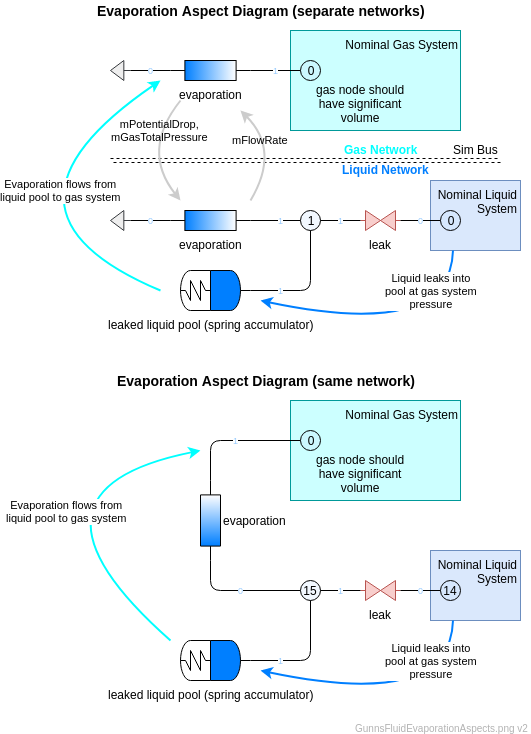GunnsFluidEvaporation - nasa/gunns GitHub Wiki

This link models evaporation of a liquid pool into a gas volume, by the equation given below. The evaporation rate ṁ is proportional to the difference between the saturation pressure Psat and the current vapor partial pressure PP, an evaporation coefficient Cevap, and the liquid pool surface area (roughly represented by the liquid pool mass m and an exponent coefficient Cmass):
The liquid pool can either be in the same network or a different network than the gas volume. This allows you the option of leaking from a separate liquid network into a gas network, or combining them as desired. The equation above is computed on the liquid side, using gas information from the gas side. The evaporation rate ṁ is simultaneously removed from the liquid pool node and added to the gas node.
The liquid can be a mixture, such as Propylene Glycol & Water (GUNNS_PG40, etc.) In such cases, this models evaporation of one specific constituent out of that mixture (i.e. the water). However since GUNNS mixed liquid types have fixed mixtures that can't change, we can't model removing only water from the PG mix. We remove an adjusted mass of the PG mix from the liquid node that would contain the same water mass as the mass of water vapor added to the gas side, so that we conserve the total water mass. The limitation is that the mass of the other liquid constituents are not conserved.
Here are limitations & assumptions of this link:
- The liquid pool has equal temperature as the air.
- We don't model the heat of phase change.
- Mixture changes to the liquid pool due to evaporation of a single species from its solution has no effect on evaporation rate.
- Effect of bulk gas velocity around the liquid pool, which normally increases evaporation rate, is ignored. The evaporation coefficient can be tuned to account for a particular velocity.
- Liquid pool displacement of the gas volume is neglected.
- This doesn't do condensation from gas back to the liquid pool.
- This doesn't do boiling of the liquid pool when the liquid pressure is below saturation.
See the aspect diagrams below for examples of how to connect this link in your drawings. For the separate networks case, there are actually 2 evaporation links, one in each network, that interact via the sim bus and combine to model the single eveporation effect. In the same network case, one evaporation link connects from the liquid pool node to the gas node.
In both cases, the evaporation link on the liquid side requires there to be a GunnsFluidAccum link to represent the pooled liquid mass.

Port Connection Rules (These are limitations on the port connection to nodes that the link enforces in run-time):
- Port 0 (the liquid side) must connect to either a liquid node or Ground. It cannot connect to a liquid node unless the liquidPoolAccum configuration data points to an accumulator link.
- Port 1 (the gas side) must connect to either a gas node or Ground.
- Both ports cannot connect to the same non-Ground node.
Other Rules (These are extra rules you should always try to follow):
- N/A.
Configuration Data Parameters:
- gasType (default = FluidProperties::NO_FLUID): This is the single gas constituent type that the liquid evaporates into, as a FluidProperties::FluidType enumeration value. If evaporating into water vapor, for example, this would be FluidProperties::GUNNS_H2O. This field must be set to an actual gas constituent (not NO_FLUID) present in the gas-side network.
- evaporationCoeff (default = 0 (1/s/kPa), must be >= 0): This controls how the evaporation rate scales with vapor pressure. This is the Cevap term in the Background description above.
- poolMassExponent (default = 0, must be within +/- 10): This configures how the liquid pool surface area scales with liquid pool mass. For instance if the entire pool forms one big sphere due to surface tension in micro-gravity, you'd use 0.667 because the area of a constant-density (i.e. liquid) sphere is proportional to mass2/3. This is the Cmass term in the Background description above.
- liquidPoolAccum (default = 0): This is the address of the liquid pool accumulator link. For the gas-side evaporation link in the separate networks case, this can be left 0. When this link connects to a liquid node, this term must point to the accumulator link. For example, if the accumulator link's name in the network is liquidPool, then this value would be &network->liquidPool.
Input Data Parameters:
- malfBlockageFlag: Same as GunnsFluidConductor. This malfunction reduces the evaporation rate from the equation given above.
- malfBlockageValue: Same as GunnsFluidConductor. A value of 1 stops evaporation completely, and 0 has no effect.
- gasTotalPressure (default = 0 (kPa), must be >= 0): This initializes the gas-side total pressure, which is used to pressurize the liquid pool accumulator. Refer to the Evaporation Aspect Diagram (separate networks) above. This term allows you to operate this link in a liquid-side only mode if you don't want to drive mGasTotalPressure via the sim bus.
- vaporPotential (default = 0 (kPa), must be >= 0): This initializes the value of (Psat - PP) in the equation above, which drives evaporation rate. This allows you to operate this link in a liquid-side only mode if you don't want to drive mPotentialDrop via the sim bus.
- evaporationRate (default = 0 (kg/s), must be >= 0): This initializes the value of evaporation rate ṁ in the equation above, for the gas-side link if you don't want to drive mFlowRate via the sim bus.
- N/A
- N/A